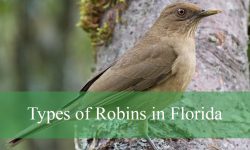Arizona’s unique mix of desert valleys, grasslands, and woodlands is home to an impressive variety of bird species, including many with distinct white tail features. These white markings can be a useful clue for identification, especially when birds are in flight or moving quickly across open terrain. Some of the most noticeable include raptors, flycatchers, and larks that flash bright white tail edges or patches as they soar, dive, or flit between perches.
This article explores 10 Birds With White Tails in Arizona, focusing on how to identify them by appearance, behavior, and habitat. From common residents like the Northern Mockingbird and Loggerhead Shrike to less frequent visitors such as the Scissor-tailed Flycatcher and Eastern Kingbird, each species brings something unique to Arizona’s birdwatching experience. Their white tails are often the first thing to catch the eye in open skies or sunlit fields.
Learning to recognize Birds With White Tails in Arizona adds another layer of enjoyment to exploring the outdoors. Knowing when and where these birds are most likely to appear can turn an ordinary walk into a memorable birding moment. Use this guide to sharpen your ID skills and discover some of the state’s most visually striking birds.
Common Birds With White Tails in Arizona
Loggerhead Shrike
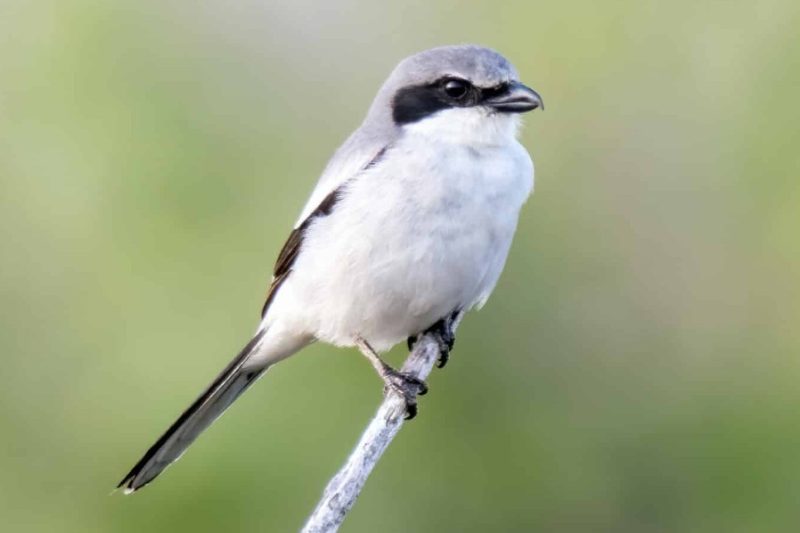
The Loggerhead Shrike is a medium-sized songbird known for its striking gray and black coloration and its hooked beak, which is unusual for a songbird. This bird measures around 9 inches in length and has a wingspan of approximately 12 inches. One of its most distinctive features is the bold black mask across its eyes, contrasting with its pale gray head and underparts.
A key identification trait is the presence of white patches on the wings and the outer tail feathers, especially visible when the bird is in flight. The tail itself is black with white outer edges, giving it a distinctive flashing appearance as it flies low over the ground. These markings help distinguish it from similar-sized birds in Arizona’s arid regions.
The Loggerhead Shrike is infamous for its carnivorous habits, often hunting insects, small reptiles, and even rodents. It is known for impaling its prey on thorns or barbed wire, which helps it to tear food apart. Despite its small size, it behaves like a small raptor and perches openly on shrubs, fences, and wires to spot prey.
In Arizona, this species is commonly found in open desert scrublands, grasslands, and agricultural fields. It is especially widespread in central and southern parts of the state, where low shrubs provide suitable hunting perches and nesting sites. It is a year-round resident in many parts of Arizona.
Northern Mockingbird
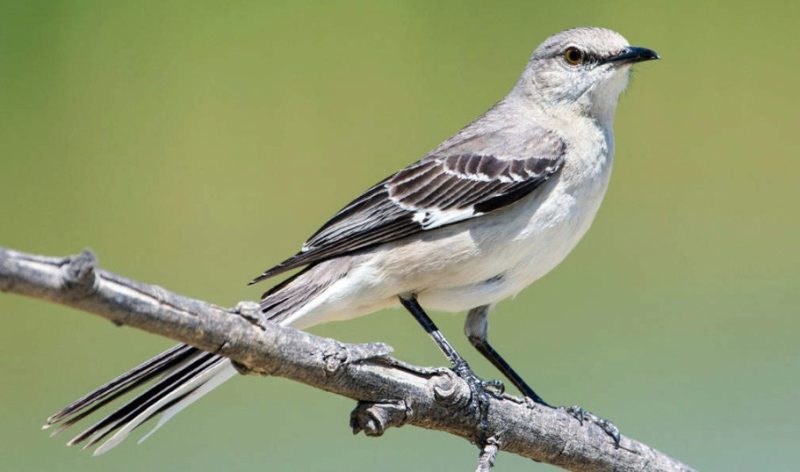
The Northern Mockingbird is a familiar and bold bird found throughout Arizona, often recognized by its long tail and vocal abilities. This bird reaches about 10 inches in length and has a slender body, long legs, and a straight bill. Its plumage is primarily gray above and whitish below, with two white wing bars and patches that are conspicuous during flight.
A distinctive feature of the Northern Mockingbird is its long tail with white outer feathers, which are especially noticeable when the bird spreads its tail in display or flies. These white tail flashes serve both as a visual cue to other birds and as a distraction to potential predators. This feature, combined with its bold behavior, makes it easy to identify even at a distance.
Northern Mockingbirds are best known for their incredible vocal range. They mimic the songs and calls of other birds and even mechanical sounds. Males often sing from high perches throughout the day and sometimes even at night. They are territorial birds and will fiercely defend their area from intruders, including much larger animals.
In Arizona, Northern Mockingbirds are found across a wide range of habitats, including urban neighborhoods, desert shrublands, and mesquite bosques. They are especially common in parks, gardens, and suburban areas, making them one of the most easily observed songbirds in the state year-round.
White-tailed Kite

The White-tailed Kite is a striking raptor with snowy white underparts and head, contrasting with gray upperparts and black shoulder patches. Measuring around 14–15 inches in length with a wingspan of approximately 40 inches, it has a graceful and buoyant flight style. Its red eyes and slim body give it a sleek appearance while hovering in the air.
The bird’s namesake feature is its entirely white tail, which stands out in flight and when perched. Unlike many other birds of prey, the tail lacks banding or darker tips, making it one of the best identifiers of the species. When soaring or hovering, its pure white tail and body are easily seen against blue skies or grassy backgrounds.
White-tailed Kites feed mainly on small mammals like voles and mice, often hunting by hovering motionless above open fields before diving down to snatch prey. Their hovering behavior is one of the most recognizable traits of the species and adds to their ghostly appearance when suspended mid-air.
In Arizona, White-tailed Kites are more commonly seen in the southern and western parts of the state, particularly in open grasslands, desert flats, and agricultural fields. Their presence depends on prey availability, and they tend to be more abundant in areas with rich rodent populations and sparse tree cover for perching and nesting.
White-tailed Hawk
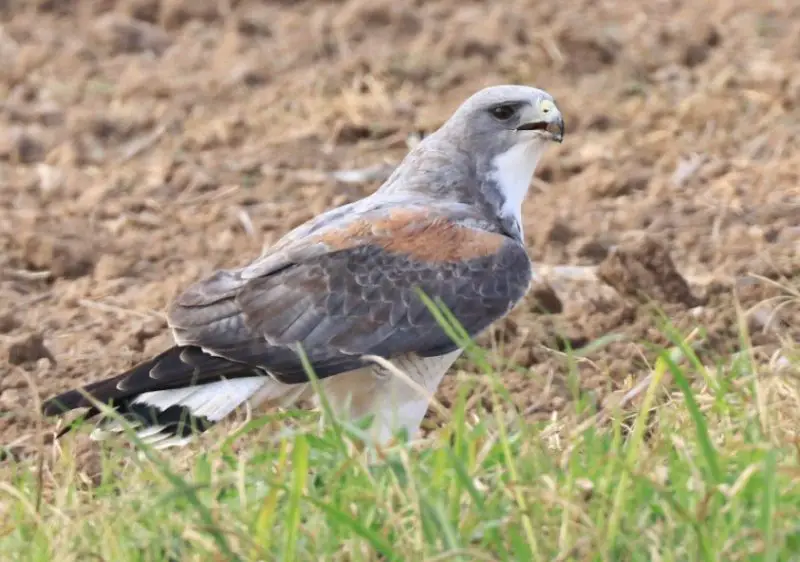
The White-tailed Hawk is a large and impressive raptor, most often seen in open country. This species can grow up to 24 inches long, with a wingspan of about 48 inches. Adults typically have a dark gray upper body, pale underparts, and a reddish shoulder patch visible in flight. The contrast between the body and tail makes identification easier.
True to its name, the tail of the White-tailed Hawk is predominantly white with a bold black band near the tip. This white tail contrasts sharply with the bird’s darker plumage and is especially noticeable when the hawk soars above open terrain. Immature birds may show less contrast and more mottled patterns.
The White-tailed Hawk often soars on thermals and scans the ground for small mammals, reptiles, and large insects. It perches on tall structures or trees and is known for its commanding presence and slow, deliberate movements. Although powerful, it avoids dense forest and prefers open visibility for hunting.
In Arizona, sightings of the White-tailed Hawk are rare but possible, mainly in the southernmost regions such as near the U.S.-Mexico border in areas like the Buenos Aires National Wildlife Refuge. It inhabits grasslands and scrublands, typically staying at low elevations where open hunting grounds are available.
Eastern Kingbird

The Eastern Kingbird is a large and aggressive flycatcher with a sleek, dark gray back and white underparts. It typically measures around 8–9 inches in length and has a broad chest and long wings. It has a distinctive black head and a small red crown patch that is rarely seen but present in close views.
One of the most recognizable features of the Eastern Kingbird is its squared-off black tail with a crisp white terminal band. This white tip stands out prominently during flight or while the bird is perched with its tail slightly fanned. It uses its tail expressively during courtship and while defending its territory.
This species is known for its aerial agility and assertive behavior. It feeds mainly on flying insects and will pursue them in midair with acrobatic turns. Eastern Kingbirds are also highly territorial and will aggressively chase off larger birds like hawks and crows from their nesting areas.
In Arizona, the Eastern Kingbird is a migratory visitor during spring and summer. It can be seen in riparian corridors, agricultural areas, and near open woodlands, especially in the southeastern parts of the state. It nests in shrubs and trees near water and is typically observed from April through early fall.
Scissor-tailed Flycatcher
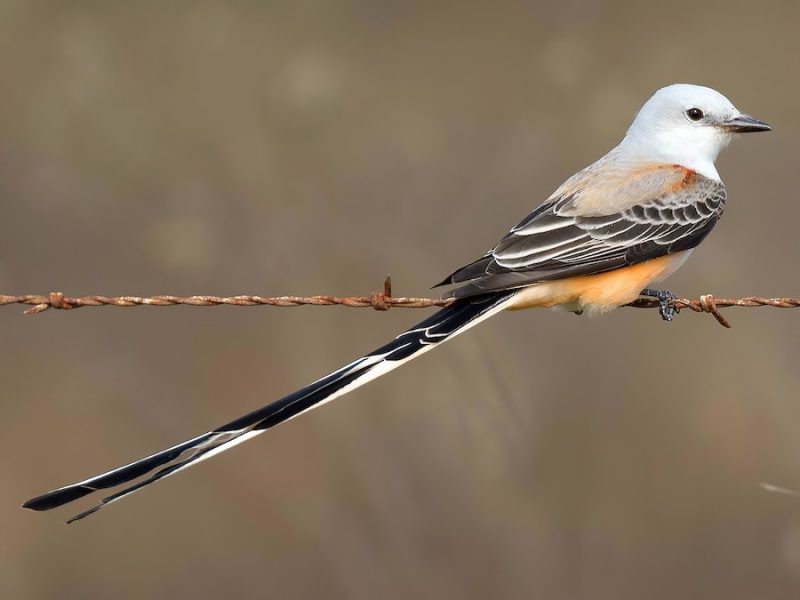
The Scissor-tailed Flycatcher is a stunning and elegant bird known for its dramatically long forked tail, which can be longer than its body. Adults are about 14–15 inches in length, with most of that length coming from their elongated tail feathers. Their body is pale gray, with salmon-pink flanks and underwings that add a splash of color in flight.
A key identification feature is the bird’s extremely long tail, which has black and white edges and is often spread open like scissors during aerial displays. This tail, combined with their graceful flight, makes the Scissor-tailed Flycatcher one of the most distinctive flycatchers in North America. Males have slightly longer tails than females.
This species is known for its acrobatic hunting style, catching insects mid-flight while performing twists and turns. It perches on fences, wires, or small trees in open areas and is often seen sallying out from these perches to snatch flying prey. During the breeding season, they are very vocal and territorial.
In Arizona, the Scissor-tailed Flycatcher is considered a rare but occasional visitor, especially during spring and fall migration. It is most likely to be seen in the southeastern part of the state or in open grasslands and agricultural fields. Sightings are unpredictable, and birdwatchers often consider it a special treat to spot one passing through.
American Kestrel (Male)

The American Kestrel is the smallest falcon in North America and one of the most colorful. Males are especially eye-catching with their slate-blue wings, rufous back and tail, and black markings on the face. They measure about 9 inches in length with a wingspan of around 20–24 inches and have a compact, upright posture when perched.
The male’s tail is a key field mark, with a pale or white underside that features a single bold black band near the tip. When the tail is fanned or seen in flight, this white coloration becomes especially prominent. From a distance, the combination of size, color, and tail pattern helps distinguish the kestrel from other raptors.
American Kestrels hunt by hovering over fields or scanning from telephone wires and fence posts. They prey on small insects, rodents, and lizards. Agile and alert, they are often seen bobbing their heads or flicking their tails. During breeding season, males perform aerial displays and provide food to females during courtship.
This species is common throughout Arizona, found in open areas such as grasslands, agricultural lands, and desert edges. It is a year-round resident in most parts of the state and is frequently seen perched along roadsides or hunting in rural areas. Nest boxes and cavities in trees or structures provide ideal nesting sites.
Red-tailed Hawk (Light Morph)
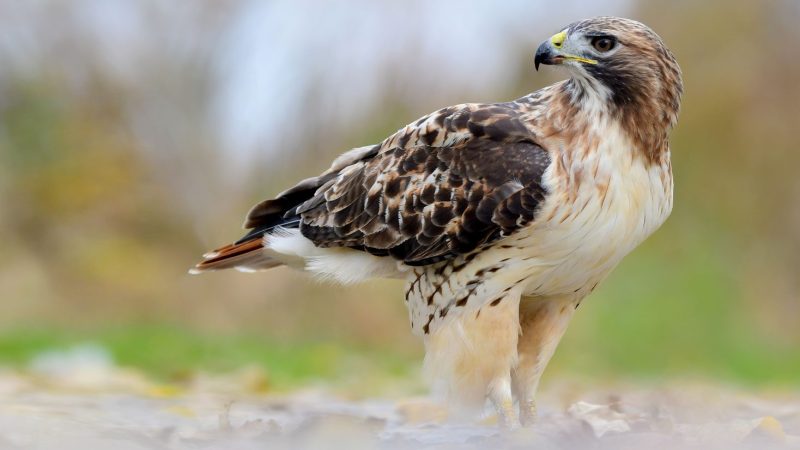
The Red-tailed Hawk is one of the most widespread and recognizable birds of prey in North America. These large hawks measure 18–26 inches long with a wingspan reaching over 50 inches. Their appearance is highly variable, and the light morph variety is particularly striking with its pale or whitish body and tail features.
While many Red-tailed Hawks have the classic rufous tail, light morph individuals may show a paler or whitish tail with faint banding, especially when seen from below. The variation in tail color can make identification challenging, but the bird’s bulky shape, broad wings, and slow soaring flight are reliable clues.
This hawk is known for its adaptability and powerful hunting skills. It preys on small mammals, birds, and reptiles, often seen soaring in circles high above the ground or perched atop trees and poles. Its loud, raspy scream is one of the most familiar raptor calls in the American Southwest.
In Arizona, Red-tailed Hawks are found statewide in all seasons. Light morphs are more frequently seen in open country, desert basins, and along mountain foothills. They are particularly abundant in areas with tall perches and open fields where prey is easy to detect and catch.
Horned Lark

The Horned Lark is a small, ground-dwelling songbird that thrives in Arizona’s open and sparsely vegetated landscapes. Adults measure about 6.5–8 inches in length and have a slender body with a short bill and rounded wings. Males sport black “horns” made of feather tufts on their head, which give the species its name.
One of the bird’s notable identification traits is its white outer tail feathers, which are often seen during short, fluttering flights or when the bird flushes from the ground. Its body is sandy brown above and pale below, with a black chest band and facial markings in breeding plumage that help with recognition.
Horned Larks forage by walking or running across the ground, pecking at seeds and insects. They are highly social during the non-breeding season and can form large flocks in open areas. Their high-pitched tinkling calls are often the first clue to their presence, especially in windy desert plains.
In Arizona, Horned Larks inhabit desert flats, grasslands, and agricultural areas throughout the year. They prefer dry, treeless environments and are particularly common in central and southern parts of the state. Their ground nests are well-hidden among clumps of grass or pebbles, making them hard to detect.
Lark Bunting (During Migration)
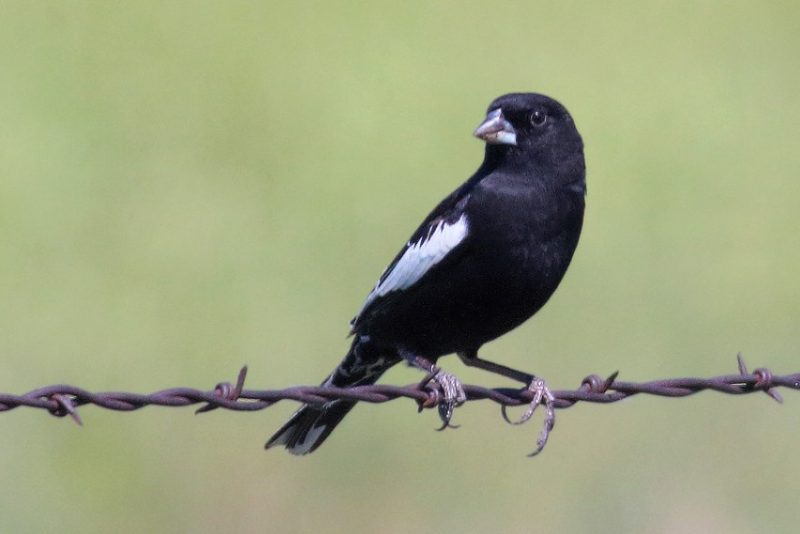
The Lark Bunting is a medium-sized sparrow that is mostly black in the male breeding plumage, with bold white wing patches and white outer tail feathers. It grows to about 5.5–7 inches in length. Females and non-breeding males are brown with streaks, but still show the distinctive white markings in flight.
Male Lark Buntings have a contrasting black body with white wing patches and white tail edges that flash during short, bouncy flights. These markings make them easily distinguishable when flying among other grassland birds. The white tail edges are especially visible as the bird lands or takes off.
Lark Buntings are known for their melodious songs, performed from perches or in midair during the breeding season. They feed on seeds and insects and often forage on the ground in open areas. Outside of breeding season, they form loose flocks and move in response to food availability and weather patterns.
In Arizona, Lark Buntings are typically observed during spring and fall migration, especially in open grasslands and prairie-like habitats. They pass through central and southeastern Arizona on their way to and from breeding grounds in the Great Plains. Their appearances can be irregular, but birders sometimes spot flocks resting or feeding in weedy fields.
Best Time and Places to See Birds With White Tails in Arizona
Arizona’s diverse landscape—ranging from deserts and grasslands to riparian woodlands and mountain forests—makes it an ideal place to spot a variety of birds with white tail features. The best time to observe these birds is during spring and fall migration (March–May and August–October), when both resident and migratory species are active. During these seasons, birds like the Eastern Kingbird, Scissor-tailed Flycatcher, and Lark Bunting pass through Arizona, while year-round residents such as the Loggerhead Shrike, Northern Mockingbird, and American Kestrel remain visible.
For consistent sightings, head to grasslands and open desert areas such as Buenos Aires National Wildlife Refuge, Las Cienegas National Conservation Area, and Agua Fria National Monument. These habitats attract White-tailed Kites, Horned Larks, and Loggerhead Shrikes. Urban parks and suburban neighborhoods, especially those with shrubs and open yards, are excellent for spotting Northern Mockingbirds and American Kestrels perched on wires or rooftops.
Riparian zones like the San Pedro River, Verde River, and areas near Patagonia offer excellent opportunities during migration seasons, especially for catching a glimpse of rarer species such as the Scissor-tailed Flycatcher or Eastern Kingbird. Birdwatching early in the morning, when birds are most active and lighting is ideal, increases the chance of identifying their distinctive white tail features in flight or while perched. Binoculars and a field guide will further enhance the experience.






